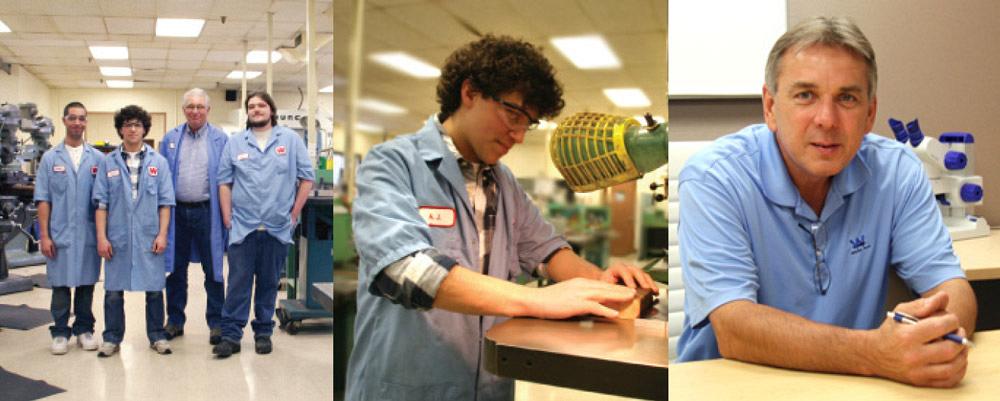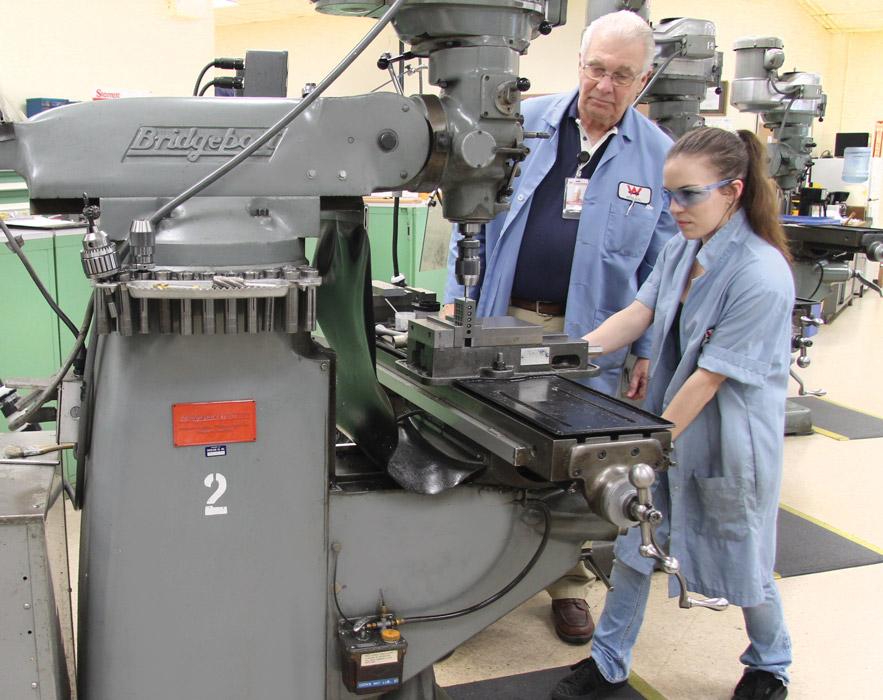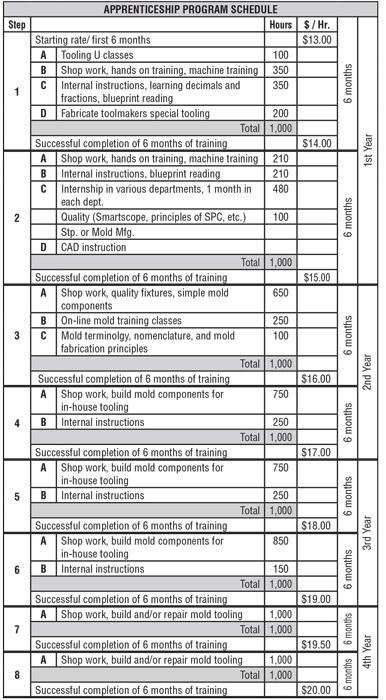Contributing editor
- FMA
- The Fabricator
- FABTECH
- Canadian Metalworking
Categories
- Additive Manufacturing
- Aluminum Welding
- Arc Welding
- Assembly and Joining
- Automation and Robotics
- Bending and Forming
- Consumables
- Cutting and Weld Prep
- Electric Vehicles
- En Español
- Finishing
- Hydroforming
- Laser Cutting
- Laser Welding
- Machining
- Manufacturing Software
- Materials Handling
- Metals/Materials
- Oxyfuel Cutting
- Plasma Cutting
- Power Tools
- Punching and Other Holemaking
- Roll Forming
- Safety
- Sawing
- Shearing
- Shop Management
- Testing and Measuring
- Tube and Pipe Fabrication
- Tube and Pipe Production
- Waterjet Cutting
Industry Directory
Webcasts
Podcasts
FAB 40
Advertise
Subscribe
Account Login
Search
Have a tool- and diemaker shortage?
How a manufacturer takes skilled-workforce problem into its own hands
- By Kate Bachman
- February 1, 2016
- Article
- Shop Management

Apprentice Program Manager Paul Rettberg, at left, heads up the four-year tool- and diemaker journeyman apprentice program at Weiss-Aug Co., East Hanover, N.J.
The skilled-worker shortage has become a much-discussed topic at industry events and conferences, at FABTECH®, around the water cooler, during association meetings, in trade publications and general audience media, and even has become a buzzword in the U.S. presidential campaigns. Some progress has been made for skills training programs to resurface, such as federal and state manufacturing training assistance programs, Manufacturing Extension Partnerships (MEPs), and those operated by trade associations such as the Fabricators & Manufacturers Association (FMA).
However, when it comes to one of the most critically needed and skilled roles in metalworking—journeyman tool- and diemaker—very few options are available. This is not a job that can be filled by the pickup load of day laborers at a street corner.
Weiss-Aug Co., a highly regarded Northeastern contract manufacturer of stampings, moldings, insert moldings, and assemblies, has taken a proactive approach to the problem by implementing its own tool- and diemaker apprentice program. Paul Rettberg, a tool- and diemaker for 45 years and a passionate advocate for U.S. workforce training, heads up the program as apprentice program manager.
“For us it became very important over the last number of years. Our president, Dieter Weissenrieder, recognized that we’ve got to have a steady flow of experienced team members working for us or else we don’t have any work.”
Weiss-Aug launched an apprenticeship program out of the German tradition in the mid-’80s and continued it for two decades. The company had to suspend it during the Great Recession of 2008-2009, but reconvened it when the economy improved. “We surveyed our workforce in 2010 and realized that a majority of our experience was in team members 55 and older.”
Weissenrieder approached the U.S. Dept. of Labor to assist with restarting the program. To have a certified program, a company has to set it up to meet department guidelines, which includes training on certain machinery. Rettberg said that the program—set up years ago, maybe as long ago as the 1940s—for a journeyman toolmaker references training on equipment that isn’t even in use anymore, like shapers, planers, radial drill presses, and comparators. “So they worked closely with us based on the new techniques and new requirements in establishing a program that meets our needs and their standards.”
Because Weiss-Aug manufactures moldings and insert moldings as well as stampings and assemblies, its apprenticeships include extensive mold manufacturing as well.
Tool- and Diemaker Certification Requirements
To qualify to administer the Dept. of Labor journeyman tool- and diemaker certification, companies have to provide an outline of the curriculum. It has to comprise 8,000 hours of training, divided into six-month segments over four years. And it has to include a progressive salary schedule.
“We had to define the program and break it into six-month segments. What are you going to teach this year, next year, the year after that, and the final year? We had to redefine which equipment that they would be trained on because most of what was referenced is no longer being used in the industry,” Rettberg said.
The program includes training in 3-D printing, laser cutting, wire EDM, CNC, and molding technologies, as well as engineering and CAD.

Apprentice Program Manager Paul Rettberg, at left, with three of his apprentices. New Product Development Manager of Stamping Steve Czapla (at right) came out of the company’s apprenticeship program.
“We want to make sure that, once they graduate, our students aren’t pigeon-holed into one position. So, over their four years, they’re introduced to various technologies. They spend time in every department to find out where their niche can be in the future.”
Weiss-Aug had to construct a progressive salary schedule over the four years of the program to meet its requirements and also to meet regional salary standards. “We’re in New Jersey where the cost of living is very high and wages are high, so we had to set the wages to entice candidates,” Rettberg said. “We’re looking for high school students, college students … men and women.”
The company’s tool- and diemaker apprentice wage scale starts at $13 an hour and escalates to $20 an hour at the end of the four-year program. “Most importantly, they then have a career, a direction, and a job at our company,” Rettberg said.
Layered Learning Curriculum
The curriculum is designed so the apprentice is first introduced to each topic, and then learns the topic more deeply in successive six-month segments. Much of the initial training introducing the trainee to major concepts is done via online coursework. The trainee completes each 1,000-hour segment before progressing to the next (see Figure 1).
Introductory Segment. In the first half of the initial six-month segment, apprentices take online classes through Tooling U. The first topic they learn is safety under the National Incident Management System (NIMS), a FEMA Emergency Management Institute course designed to prepare students for emergencies.
During this introductory period, apprentices also learn about the manual machines they will use to build die components, including grinders, milling machines, drill presses, band saws, and lathes. “They learn how to use the grinder, how to be accurate with it, how to mill closely—how to mill it the right way using the right cutters,” Rettberg said. “The final part of any die work is grinding. It is the most critical part in finishing blocks and components that go into a tool, so they learn how to grind to very, very tight tolerances.”
While they learn how to use the machines, they apply what they learn to building tools for themselves to use throughout their apprenticeship and afterward. “So by using the equipment to make these tools, they’re also learning about the equipment,” Rettberg said. They make vises, parallels, clamping devices, tools that every diemaker or journeyman will need to use throughout their careers. The apprentices can save hundreds of dollars by making the tools themselves, honing their skills in the process.
The apprentices are introduced to blueprint reading in that first six months as well. They learn or relearn about decimals and fractions. “It’s fundamental, but you’d be surprised how many young people out of high school can’t read a tape measure,” Rettberg said.
Second Segment. In the second period, apprentices get more hands-on machine training. They receive instruction on how different metals react and when to use lubricants.
They learn the terminology of the trade. “I’ve written my own dictionary, a couple hundred words, with terms associated with what we do,” Rettberg said. “It’s part of my vocabulary, but other people don’t understand what I’m talking about. So I teach that to them.”

During the introductory period, apprentices learn about the manual machines they will use to build die components, including grinders, milling machines, drill presses, band saws, and lathes, as well as laser cutting technologies, CNC milling and machining, wire EDM, and quality inspection instruments.
Apprentices receive additional blueprint reading training on more complex blueprints.
They spend one month in various departments, including the quality assurance department.
They get some CAD instruction. “Each apprentice is given a computer on his bench, and they’ll spend time learning how to use it.”
Apprentices learn about using laser cutting technologies, as well as CNC milling and machining, wire EDM, and quality inspection instruments. They learn about vision measuring systems in the quality department.
Rettberg said that having well-trained employees is tantamount to achieving the zero defects Weiss-Aug’s customers expect. “Defects are a killer for any company. If you start to produce parts that do not meet the customer’s specifications and ship them to a customer, it’s a big problem. Apprentices learn how to use quality testing instruments to inspect the parts that are shipped to customers to ensure zero defects.
“So, in the second six months, they learn more about the principles of die fabrication, of milling, and grinding. What is a die? What are the components? How do they go together? What’s required?” Rettberg said.
Third Segment. As part of training to build components, trainees start building a real die while they are paired up with a diemaker.
In this segment, apprentices also get some instruction that may be unique to Weiss-Aug: mold fabrication. “We do overmolding, inline molding, or insert molding for the medical, automotive, and electronics industries. We’d be foolish not to train our apprentices on mold technology,” Rettberg said. Though the company doesn’t build its own molds, journeymen must know how to service the molds, he said. “To do so, you have to understand mold technology.”
Trainees take online training classes, learning mold nomenclature and mold fabrication principles.
Fourth Through Eighth Segments. Apprentices learn, hands-on, how to build mold components for in-house tooling in the fourth, fifth, and sixth segments, progressing to building and repairing actual molds in the last two periods. They receive what Rettberg calls “internal instructions.”

Figure 1
Tool- and diemaker journeyman apprentices are first introduced to tool and mold fabrication
principles, then given progressively more detailed training throughout the 8,000-hour
program.
“Internal instructions is teaching what goes on inside a stamping die or a mold to understand why certain things happen, and what you have to do to fix it. People may think that you just put a block in, you stamp, and out comes your part. Well, a majority of times, it doesn’t come out the way you wanted it to, visually or dimensionally. So what caused that? Those are the principles that we teach, both for molding and stampings dies.”
Apprentices are trained on the specifics of materials, learning about their behavior when they’re cut.
Throughout the remaining periods, the trainees build on what they’ve learned earlier, with more hands-on training in the shop. “Once you get into the remaining six-month periods, a lot of things seem repetitious. But it’s part of our training program that they know everything really well,” Rettberg said.
Rettberg said the program is designed to allow apprentices to progress at their own speed. “The quicker they pick it up, the better they do it, the more we introduce to them. So if it takes an extra six months or even a year … the point is that he or she is picking it up and understanding the principles.”
The Weiss Whys
Rettberg said that other companies grapple with understanding the importance and value of an apprenticeship program. “Most people considering a training program look at the cost first and don’t think about the outcome of it. We understand that the program is expensive. On the other hand, what would the outcome be of not doing it? Two, three years from now when we cannot find a good toolmaker, diemaker, or moldmaker, we’d be stuck because we wouldn’t have the capabilities to produce the parts we need and the company would stop growing.”
Rettberg added that despite the program’s expense, management doesn’t require apprentices to sign a contract to stay on, but asks them to stay on for at least a year.
Stay they do. Some have continued on as tool- and diemakers for the company, while others moved into other roles within the company, including positions like new product development manager, toolroom manager, and supervisor of manufacturing. “One of my grads attends the local community college to get his associate degree in mechanical engineering. Two others have completed their associates and are now going for their bachelors in engineering technology … all paid for by Weiss-Aug,” he said.
Three of the four apprentices the company hired in 2011 have graduated, and the fourth is scheduled to do so by the time of this issue publication.
The apprenticeship program is ongoing. “In fact, we’re looking for the next generation of apprentices right now. In order for us to survive, we have to have these valuable assets learning the new trade,” Rettberg said.
He added, “Training does work, and we will continue to do it because these individuals are our company’s future.”
Images courtesy of Weiss-Aug Co. Inc., 220 Merry Lane, East Hanover, NJ 07936, 973-887-7600, prettberg@weiss-aug.com. www.weiss-aug.com
About the Author

Kate Bachman
815-381-1302
Kate Bachman is a contributing editor for The FABRICATOR editor. Bachman has more than 20 years of experience as a writer and editor in the manufacturing and other industries.
subscribe now

The Fabricator is North America's leading magazine for the metal forming and fabricating industry. The magazine delivers the news, technical articles, and case histories that enable fabricators to do their jobs more efficiently. The Fabricator has served the industry since 1970.
start your free subscription- Stay connected from anywhere

Easily access valuable industry resources now with full access to the digital edition of The Fabricator.

Easily access valuable industry resources now with full access to the digital edition of The Welder.

Easily access valuable industry resources now with full access to the digital edition of The Tube and Pipe Journal.
- Podcasting
- Podcast:
- The Fabricator Podcast
- Published:
- 04/16/2024
- Running Time:
- 63:29
In this episode of The Fabricator Podcast, Caleb Chamberlain, co-founder and CEO of OSH Cut, discusses his company’s...
- Industry Events
16th Annual Safety Conference
- April 30 - May 1, 2024
- Elgin,
Pipe and Tube Conference
- May 21 - 22, 2024
- Omaha, NE
World-Class Roll Forming Workshop
- June 5 - 6, 2024
- Louisville, KY
Advanced Laser Application Workshop
- June 25 - 27, 2024
- Novi, MI
































